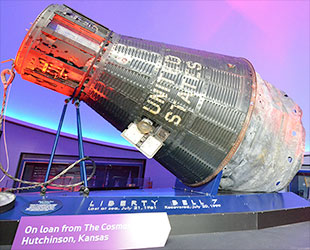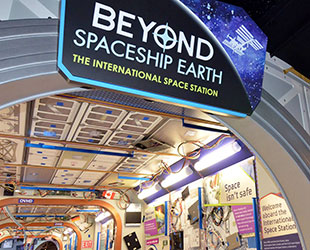June 27, 2016 — The space capsule flown by the second American to launch into space is now part of a new exhibit in the home state of its astronaut pilot.
Liberty Bell 7, the Mercury spacecraft piloted by Indiana-born Virgil "Gus" Grissom, debuted on Saturday (June 25) at The Children's Museum of Indianapolis. The 55-year-old capsule is one of the highlights of the museum's three-part exhibit, "Beyond Spaceship Earth," which also features a walk-through recreation of the International Space Station and an Indiana Astronaut Wall of Fame honoring hoosiers who have contributed to the nation's space program.
"Experience the story of the Liberty Bell 7 [spacecraft] in an immersive domed theater show," the museum's website reads. "See, hear, and feel the amazing story of how Gus Grissom became the second American to see space with his own eyes and pilot his capsule safely home."
Launched July 21, 1961 on Grissom's 15-minute Mercury-Redstone 4 sub-orbital mission, the capsule famously sank soon after splashing down. It remained on the ocean floor until July 1999, when the Liberty Bell 7 was recovered by an expedition organized by the Discovery Channel and the Cosmosphere space museum in Hutchinson, Kansas.

Liberty Bell 7 is on a three-year loan to The Children's Museum of Indianapolis from the Cosmosphere museum in Kansas. (TCMI) |
Now on a three-year loan to The Children's Museum, the Liberty Bell 7 is the first space artifact to be featured in the Schaefer Planetarium and Space Object Theater. Guests encounter the restored capsule during a multimedia show that includes seats that rumble in time with the imagery of the spacecraft's launch and an actor who portrays Mercury astronaut Gordon Cooper.
"We are really going to excite these young people," stated David Wolf, a former shuttle-era astronaut who was born in Indianapolis and helped develop Beyond Spaceship Earth. "I see this exhibit helping young people's dreams come true."
Some of Wolf's own spaceflight artifacts, including one of his crew notebooks and his flown Russian dictionary, are displayed within the museum's International Space Station exhibit, which includes hands-on "space task" activities to show visitors to how astronauts live in Earth orbit today.
"I've been in space quite a bit and one of the frustrations is how to explain what it's like. It is so different, so amazing," described Wolf in a video released about the making of the exhibit. "We want to bring that experience to the visitors of The Children's Museum and we can do that — even in the presence of gravity."

Beyond Spaceship Earth at The Children's Museum of Indianapolis includes a recreation of the International Space Station. (TCMI) |
Beyond Spaceship Earth also showcases the astronauts who have called The Hoosier State their home. In addition to Grissom — who tragically died in the 1967 Apollo 1 pad fire — and Wolf, ten of the nation's other space explorers began life in Indiana, including Frank Borman, who helmed Apollo 8, the first mission to orbit the moon; Jerry Ross, a record seven-time spacewalker; and Charlie Walker, the first industry-appointed payload specialist.
Other Indiana-born astronauts include Joseph Allen, Tony England, Kevin Ford, Mark Brown, Serena Aunon and the late Donald Williams and Janice Voss.
The exhibit's Astronaut Wall of Fame displays artifacts and images honoring the state's space travellers, as presented in collaboration with Purdue University of West Lafayette, Indiana.
Beyond Spaceship Earth spans more than 3,600 square feet (335 sq. meters) on the lower level of The Children's Museum of Indianapolis, the largest children's museum in the world. The $8 million exhibit was made possible by a NASA grant and private donations.
Beyond Spaceship Earth is a permanent addition to The Children's Museum. Liberty Bell 7 will be part of the exhibit through 2019 and then will return to the Cosmosphere.
